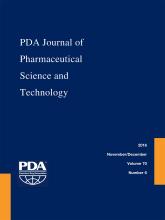Research ArticleResearch
Qualification of a Quantitative Method for Monitoring Aspartate Isomerization of a Monoclonal Antibody by Focused Peptide Mapping
Mingyan Cao, Wenjun (David) Mo, Anthony Shannon, Ziping Wei, Michael Washabaugh and Patricia Cash
PDA Journal of Pharmaceutical Science and Technology November 2016, 70 (6) 490-507; DOI: https://doi.org/10.5731/pdajpst.2015.006239
Mingyan Cao
Analytical Biotechnology Department, MedImmune Inc, Gaithersburg, MD
Wenjun (David) Mo
Analytical Biotechnology Department, MedImmune Inc, Gaithersburg, MD
Anthony Shannon
Analytical Biotechnology Department, MedImmune Inc, Gaithersburg, MD
Ziping Wei
Analytical Biotechnology Department, MedImmune Inc, Gaithersburg, MD
Michael Washabaugh
Analytical Biotechnology Department, MedImmune Inc, Gaithersburg, MD
Patricia Cash
Analytical Biotechnology Department, MedImmune Inc, Gaithersburg, MD

Reference
- 1.↵
- Geiger T.,
- Clarke S.
- 2.↵
- Manning M. C.,
- Patel K.,
- Borchardt R. T.
- 3.↵
- Cacia J.,
- Keck R.,
- Presta L. G.,
- Frenz J.
- 4.↵
- Wakankar A. A.,
- Borchardt R. T.,
- Eigenbrot C.,
- Shia S.,
- Wang Y. J.,
- Shire S. J.,
- Liu J. L.
- 5.↵
- Cloos P. A.,
- Fledelius C.
- 6.↵
- Clarke S.
- 7.↵
- Oliyai C.,
- Borchardt R. T.
- 8.↵
- 9.↵
- 10.↵
- 11.↵
- 12.↵
- Mire-Sluis A. R
- 13.↵
- Rehder D. S.,
- Chelius D.,
- McAuley A.,
- Dillon T. M.,
- Xiao G.,
- Crouse-Zeineddini J.,
- Vardanyan L.,
- Perico N.,
- Mukku V.,
- Brems D. N.,
- Matsumura M.,
- Bondarenko P. V.
- 14.↵
- Doyle H. A.,
- Gee R. J.,
- Mamula M. J.
- 15.↵
- 16.↵
- O'Connor P. B.,
- Cournoyer J. J.,
- Pitteri S. J.,
- Chrisman P. A.,
- McLuckey S. A.
- 17.↵
- 18.↵
- 19.↵
- 20.↵
- 21.↵
- Diepold K.,
- Bomans K.,
- Wiedmann M.,
- Zimmermann B.,
- Petzold A.,
- Schlothauer T.,
- Mueller R.,
- Moritz B.,
- Stracke J. O.,
- Mølhøj M.,
- Reusch D.,
- Bulau P.
- 22.↵
- Eakin C. M.,
- Miller A.,
- Kerr J.,
- Kung J.,
- Wallace A.
- 23.↵Guidance for Industry. Q7A. Good Manufacturing Practice Guidance for Active Pharmaceutical Ingredients. Available from http://www.fda.gov/Drugs/GuidanceComplianceRegulatoryInformation/Guidances/ucm065005.htm.
- 24.↵
- Wyndham K. D.,
- O'Gara J. E.,
- Walter T. H.,
- Glose K. H.,
- Lawrence N. L.,
- Alden B. A.,
- Izzo G. S.,
- Hudalla C. J.,
- Iraneta P. C.
- 25.↵
In This Issue
PDA Journal of Pharmaceutical Science and Technology
Vol. 70, Issue 6
November/December 2016
Qualification of a Quantitative Method for Monitoring Aspartate Isomerization of a Monoclonal Antibody by Focused Peptide Mapping
Mingyan Cao, Wenjun (David) Mo, Anthony Shannon, Ziping Wei, Michael Washabaugh, Patricia Cash
PDA Journal of Pharmaceutical Science and Technology Nov 2016, 70 (6) 490-507; DOI: 10.5731/pdajpst.2015.006239
Qualification of a Quantitative Method for Monitoring Aspartate Isomerization of a Monoclonal Antibody by Focused Peptide Mapping
Mingyan Cao, Wenjun (David) Mo, Anthony Shannon, Ziping Wei, Michael Washabaugh, Patricia Cash
PDA Journal of Pharmaceutical Science and Technology Nov 2016, 70 (6) 490-507; DOI: 10.5731/pdajpst.2015.006239
Jump to section
Related Articles
- No related articles found.
Cited By...
- No citing articles found.





